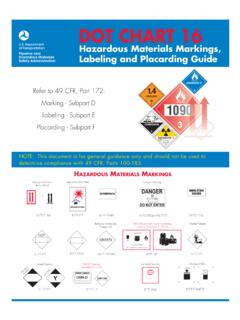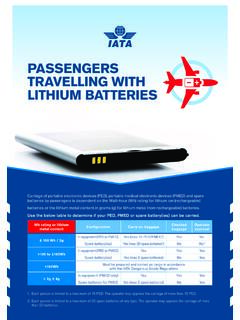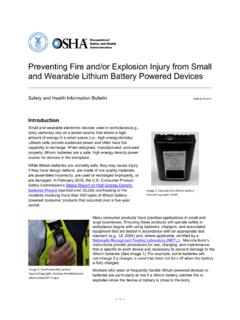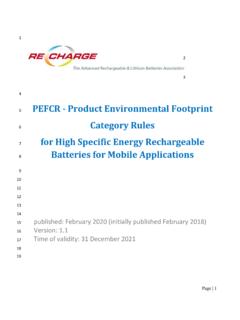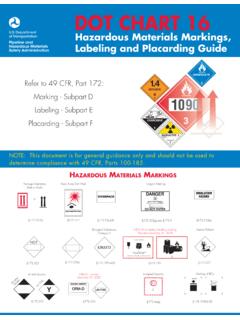Transcription of PEFCR - Product Environmental Footprint Category Rules …
1 Page | 1 PEFCR - Product Environmental Footprint Category Rules for High Specific Energy Rechargeable Batteries for Mobile Applications published: February 2018 Version: H Time of validity: 31 December 2020 Page | 2 Preface This document has been developed with the Technical Secretariat of the Batteries Pilot during the Commission PEF Project Authors Company name Sector Cl mence Siret Saft battery manufacturer Jan Tytgat Umicore Material producer and battery recycler Thomas Ebert Apple OEM manufacturer Mark Mistry Nickel Institute Metals producer Colin Thirlaway Stanley Black & Decker OEM manufacturer Bertrand Schutz Eramet Material producer and battery recycler Demosthene Xhantopoulos Eramet Material producer and battery recycler Jean-Pol Wiaux Recharge battery manufacturer Claude Chanson Recharge battery manufacturer Willy Tomboy Recharge battery manufacturer Carol Pettit Cobalt Institute Metals producer Johannes Gediga Thinkstep LCA Specialist Marta Bonell Thinkstep LCA Specialist Viviana Carrillo Thinkstep LCA Specialist Page | 3 Disclaimer The European
2 Commission accepts no responsibility whatsoever nature to third parties to whom this guidance , or any part thereof, is made known. Any such party relies on the guidance at their own risk. Page | 4 PREFACE .. 2 I. LIST OF TABLES .. 6 II. LIST OF FIGURES .. 7 III. ACRONYMS .. 8 IV. DEFINITIONS .. 10 1 INTRODUCTION .. 20 2 GENERAL INFORMATION ABOUT THE PEFCR .. 21 TECHNICAL SECRETARIAT .. 21 CONSULTATIONS AND STAKEHOLDERS .. ERREUR ! SIGNET NON DEFINI. REVIEW PANEL AND REVIEW REQUIREMENTS OF THE PEFCR .. 22 REVIEW STATEMENT .. 23 GEOGRAPHIC VALIDITY .. 23 LANGUAGE .. 23 CONFORMANCE TO OTHER DOCUMENTS .. 23 3 PEFCR SCOPE .. 24 Product CLASSIFICATION .. 26 REPRESENTATIVE PRODUCTS .. 26 FUNCTIONAL UNIT AND REFERENCE FLOW .. 28 SYSTEM BOUNDARY .. 31 Raw material acquisition stage and Production stage .. 34 Use stage .. 37 End-of-Life stage .. 37 EF IMPACT ASSESSMENT.
3 38 40 4 MOST RELEVANT IMPACT CATEGORIES, LIFE CYCLE STAGES, PROCESSES AND ELEMENTARY FLOWS .. 42 5 LIFE CYCLE INVENTORY .. 46 LIST OF MANDATORY COMPANY-SPECIFIC DATA .. 46 LIST OF PROCESSES EXPECTED TO RUN BY THE COMPANY .. 51 DATA 51 DATA QUALITY REQUIREMENTS .. 52 COMPANY SPECIFIC DATASETS .. 52 DATA NEEDS MATRIX (DNM) .. 55 Processes in situation 1 .. 57 Processes in situation 2 .. 57 Processes in situation 3 .. 59 WHICH DATASETS TO USE? .. 59 HOW TO CALCULATE THE AVERAGE DQR OF THE STUDY .. 60 ALLOCATION Rules .. 60 ELECTRICITY MODELLING .. 60 Page | 5 CLIMATE CHANGE 63 MODELLING OF WASTE AND RECYCLED 66 6 LIFE CYCLE STAGES .. 68 RAW MATERIAL ACQUISITION AND PRE-PROCESSING .. 68 AGRICULTURAL MODELLING (NOT APPLICABLE IN THIS PEFCR ) .. 70 MANUFACTURING .. 70 DISTRIBUTION STAGE .. 72 USE STAGE .. 74 END OF LIFE .. 76 7 PEF RESULTS .. 80 BENCHMARK VALUES.
4 80 PEF PROFILE .. 82 ADDITIONAL TECHNICAL INFORMATION .. 82 ADDITIONAL Environmental INFORMATION .. 82 8 VERIFICATION .. 83 9 REFERENCES .. 85 ANNEX 1 LIST OF EF NORMALISATION AND WEIGHTING FACTORS .. 88 ANNEX 2 - CHECK-LIST FOR THE PEF STUDY .. 90 ANNEX 3 - CRITICAL REVIEW REPORT OF THE PEFCR .. 91 ANNEX 4 - OTHER ANNEXES .. 97 Page | 6 I. List of tables Table 1: Product classification according to CPA .. 26 Table 2: Representative products as basis of the PEF screening study /Screening 2015/ .. 27 Table 3 Key aspects of the Functional Unit .. 29 Table 4 Parameters used for the calculation of functional unit based on an example .. 30 Table 5: Parameters used for the association to the reference flow .. 31 Table 6: Life cycle stages .. 31 Table 7: List of the impact categories to be used to calculate the PEF profile .. 39 Table 8: most relevant impact 42 Table 9: most relevant life cycle stages.
5 43 Table 10: most relevant processes .. 44 Table 11: Mandatory process: Cell assembly and formation 48 Table 12: Mandatory process: battery OEM assembly .. 49 Table 13: elementary flows .. 50 Table 14: other flows .. 50 Table 15:List of data gaps and proxies to be used .. 52 Table 16: How to assess the value of the DQR criteria for datasets with company-specific information .. 54 Table 17: Data Needs Matrix (DNM) *Disaggregated datasets shall be used.. 56 Table 18: How to assign the values to parameters in the DQR formula when secondary datasets are used .. 58 Table 19: Allocation Rules for electricity.. 62 Table 20: Raw material acquisition and processing .. 68 Table 21: Manufacturing- cell assembly and formation.. 70 Table 22 Manufacturing- battery assembly .. 71 Table 23: Distribution.. 73 Table 24: Guideline for calculation of quantity of Functional Units and Reference flow .. 75 Table 25: Use stage.
6 76 Table 26: End of Life.. 76 Table 27: EoL Scenario in EU to be applied in the PEF declaration .. 79 Table 28: Characterised benchmark values for the 4 representative products .. 80 Table 29: normalized benchmark values for the 4 representative products .. 81 Table 30: Weighted and normalized benchmark values for the 4 representative products .. 81 Table 31: use phase scenarios comparison .. Erreur ! Signet non d fini. Table 32: effect of use phase scenarios on Environmental impacts .. Erreur ! Signet non d fini. Page | 7 II. List of figures Figure 1: Definition of a unit process dataset and an aggregated process datasetErreur ! Signet non d fini. Figure 2: An example of a partially aggregated dataset, at level 1.. Erreur ! Signet non d fini. Figure 3: Representative products components .. Erreur ! Signet non d fini. Figure 4: System boundaries life cycle of battery system .. Erreur ! Signet non d fini.
7 Figure 5: Cradle to gate processes for Li-ion battery production .. Erreur ! Signet non d fini. Figure 6: Cradle to gate processes for NiMH battery production .. Erreur ! Signet non d fini. Figure 7: Dismantling and recycling processes .. Erreur ! Signet non d fini. Page | 8 III. Acronyms AF Allocation Factor AP Acidification Potential AR Allocation Ratio B2B Business to Business B2C Business to Consumer BHU battery control unit BMU battery management unit BoC Bill of Components BoM Bill of Materials BP Bonne Pratique BREF Best Available Techniques Reference Document CF Characterization Factor CFF Circular Footprint Formula CFF-M Circular Footprint Formula Modular form CMWG Cattle Model Working Group CPA Classification of Products by Activity CPT Cordless power tool DC Distribution Centre DMI Dry Matter Intake DNM Data Needs Matrix DOD Depth of Discharge ( battery % of use at each cycle) DPE Domestic person equivalent DQR Data Quality Rating EA Economic Allocation EC European Commission EF Environmental Footprint EI Environmental Impact ELCD European Life Cycle Database ELV Electric vehicles (e-mobility)
8 EoL End-of-Life EP Eutrophication Potential FU Functional Unit GaBi Ganzheitliche Bilanzierung (German for holistic balancing) GE Gross Energy intake GR Geographical Representativeness GHG Greenhouse Gas GWP Global Warming Potential HD Helpdesk HEV Hybrid Electric Vehicle ICT Information and Communication Technology IEC International Electrochemical Commission Page | 9 ILCD International Reference Life Cycle Data System IPCC Intergovernmental Panel on Climate Change ISO International Organisation for Standardisation JRC Joint Research Centre LCDN Life Cycle Data Network LCA Life Cycle Assessment LCI Life Cycle Inventory LCIA Life Cycle Impact Assessment Li lithium metal LCO lithium battery using a Cobalt Oxide based cathode LFP lithium battery using an Iron Phosphate based cathode LT Lifetime MSI Materials Sustainability Index (provided by SAC) NDA Non Disclosure Agreement NGO Non-Governmental Organisation NMVOC Non-methane volatile compounds NiMH Nickel Metal Hydride NMC lithium battery using a Nickel Manganese Cobalt Oxide based cathode ODP Ozone Depletion Potential OEM Original Equipment Manufacturer P Precision PCR Product Category Rules PEF Product Environmental Footprint PEFCR Product Environmental Footprint Category Rules PEHV Plug-In Hybrid Electric Vehicle POCP Photochemical Ozone Creation Potential PWB-PCB Populated Printed Wiring Board RF Reference Flow RP Representative Product SB System Boundary SC Steering Committee SLI Starting-Lighting-Ignition- battery SMRS Sustainability Measurement & Reporting System SS Supporting study TAB Technical Advisory Board TeR Technological Representativeness ThMU Thermal management unit TiR Time Representativeness TS Technical Secretariat UNEP United Nations Environment UPS Uninterruptible
9 Power supply USGS United States Geological Survey UUID Universally Unique Identifier VOC Volatile Organic Compound Wh Watt-hourPage | 10 IV. Definitions For all terms used in this guidance and not defined below, please refer to the most updated version of the Product Environmental Footprint (PEF) Guide, ISO 14025:2006, ISO 14040-44:2006, and the ENVIFOOD Protocol. Activity data - This term refers to information which is associated with processes while modelling Life Cycle Inventories (LCI). In the PEF Guide it is also called non-elementary flows . The aggregated LCI results of the process chains that represent the activities of a process, are each multiplied by the corresponding activity data1 and then combined to derive the Environmental Footprint associated with a process (See Figure 1). Examples of activity data include quantity of kilowatt-hours of electricity used, quantity of fuel used, output of a process ( waste), number of hours equipment is operated, distance travelled, floor area of a building, etc.
10 In the context of PEF the amounts of ingredients from the bill of material (BOM) shall always be considered as activity data. Active materials: battery material directly linked to the electrochemical performance: includes the Cathode, Anode, Electrolyte and Separator. Aggregated dataset - This term is defined as a life cycle inventory of multiple unit processes ( material or energy production) or life cycle stages (cradle-to-gate), but for which the inputs and outputs are provided only at the aggregated level. Aggregated datasets are also called "LCI results", cumulative inventory or System processes datasets. The aggregated dataset can have been aggregated horizontally and/or vertically. Depending on the specific situation and modelling choices a "unit process" dataset can also be aggregated. See Figure 12. Allocation: An approach to solving multi-functionality problems.











